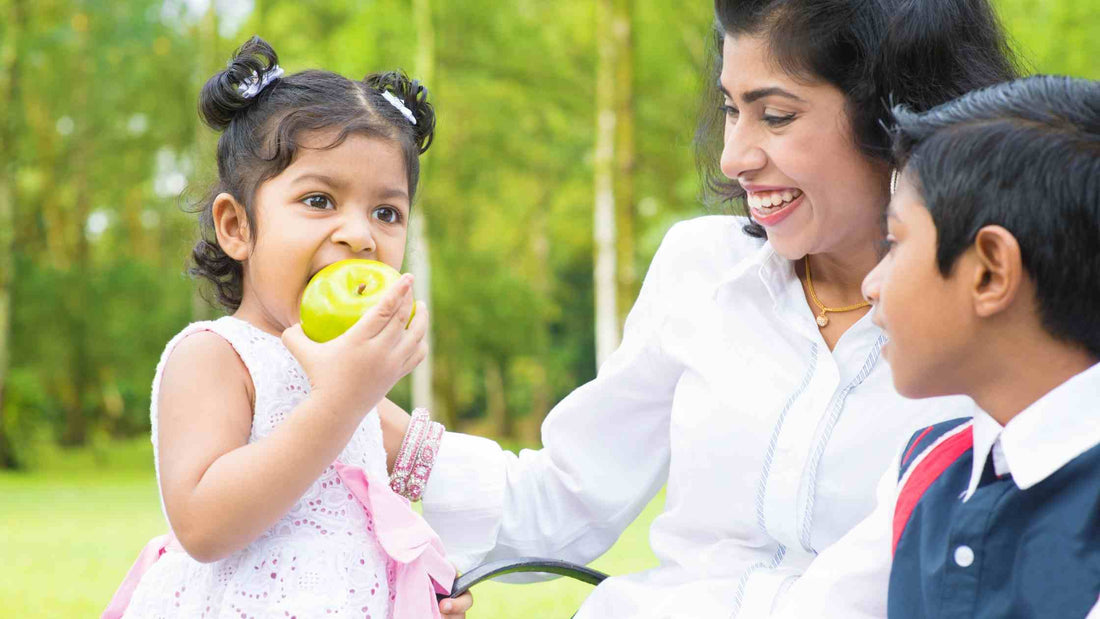
Feeding Smart right from start
Naturally YoursShare

Every Mom (including me) wants the best for her little one!!
Right from the moment a baby is born, mothers are bombarded with lots of advices of what to do, what to feed, how to feed, and the list goes on and on!
First 6 months, a baby is exclusively breast fed as mothers milk contains almost everything that the little one requires.
But, once your little munchkin turns 6 months old, liquids, semisolids and solids can be introduced.
Feeding babies can be fun and an exciting milestone (can be messy also), if you are aware of exactly what to give them!
Think of all the tastes and textures that awaits your little one- from savoury to cheesy to juicy fruits to creamy avocado!
Below is the list of tasty and healthy food options that you can try even if a good portion of them ends up on her bib, the tray or even the floor!!
INFANTS-
6-8 months-
This is the time when you will be introducing the real food for the first time. It is advisable to start 1 food at a time to see its tolerance levels.
Usually, it starts with some boiled and cooled sips of water and single grain cereals like thin Rice water, dal water, thin wheat porridge or Ragi porridge.
Remember, no need to add any salt or sugar initially- it’s best if your baby learns to like it without the added seasonings!
The baby might have only 2-3 spoons at a time.
Once your baby is used to swallowing runny cereal, thicken it by using more cereal and less water.
Next you can start introducing thin clear soups, or fruit pulp (better to use a fruit sucker available over the counter).
Few recipes I can share can be Lime juice, coconut water, strained mix veg soup, thin khichdi, Porridges made in thin buffaloes’ milk,
9-12 months
As soon as your child is able to, transition them away from smooth purees.
Incorporate finger foods like fresh curd (with little sugar or mashed fruits), mashed banana, mashed papaya, stewed apple (very small cut), Mashed potato, sweet potato or butternut squash.
Also let your baby explore simple, soft finger foods like boiled peas or beans, tofu or paneer, hard-boiled egg, quinoa, or shredded cheese
Disclaimer- Keep breast feeding or using infant formula until the age of 12 months!
TODDLERS
Now it is the time to take those taste buds to the next level!
Toddlers can eat almost all the foods from the basic food groups like cereals, pulses, fruits, veggies, dairy, meat, nuts and oils.
Your slightly grown up one is now learning to eat more solid foods and is more active now.
He can start having mashed chapati (or even soft chapati) with vegetable, dal and rice.
Day to day and meal to meal appetite changes are normal. Make food simple, plain and recognizable. More the colour, more is the attraction.
Few examples I can share can be- All kind of small cut fruits, Baby puffs, Baby rice crackers, Cookies or biscuits dipped in milk, rice and dal, soft cooked pastas, noodles, thin soft parathas, soft idlis and dosa, kheer and also whatever the child wishes to taste.
You can add little salt, sugar or spice wherever needed.
Always remember-
Avoid slippery foods (candys, cough drops) or foods that might choke (hard nuts, popcorn, large sized chips, raw carrots, raisins, seeds).
Cut the food into small pieces and serve it in attractive plates as your child might want to eat my himself or herself now.
KINDERGARTENER-
Kindergarteners between the age of 3 and 5 are able to eat a variety of foods.
Nutrition during preschool years is an opportunity for parents to teach kids about healthy food options.
It’s time to offer the child food from the family pot!
Let your child decide how much to eat or restrict the amount of food you allow them to eat. Some days they might eat more, while on some days they might eat less too!
Generally, a pre-schooler should be eating between 1200 and 1600 calories per day.
The best way to help kids eat on their own is to help them make their own meal, for instance, a simple sandwich or bake a cake (under parents’ supervision), or some canapies.
Set regular meal and snack times so that kids don’t graze all day long.
THE ELDER ONES-
Healthy food for school age children includes a variety of fresh foods from almost all food groups.
This is their growing age and of course to keep in mind, the time constraint as your child might be busy with his school, homework, classes etc. Their intake might increase due to increased play times or even exam stress.
However, some healthy foods are a must for them- Milk, curd, paneer, green leafy veggies, mix nuts or energy bars and lots and lots of water.
As a Dietician, I would advise traditional homemade laddus, chikkis, smoothies and milkshakes to meet their growing energy demands.
Not to forget, children at this age might be attracted to junk like fries, desserts and sweets.
Make sure you limit such foods to once in 10 days. But if the importance of healthy eating is clear in their minds, this problem would not occur.
In a nutshell-
Remember, not everything on your kids’ plate has to be a superfood. Do not force feed them.
Let children explore, taste and smell their food. Encourage zero food wastage policy once they are big.
The good news is that you don’t need a masters in nutrition always to raise healthy kids.
Following above mentioned healthy choices can encourage your kids to eat right and maintain a healthy weight!
ABOUT THE AUTHOR

Sneha Jain, Dietician
Sneha is a Post graduate with specialization in Nutrition and Dietetics. She is a university topper and holds 5+ years of experience in Apollo hospitals, VLCC, slimsutra and first cry fit-kids .
She has successfully counselled clients all over India for weight loss, weight gain, diabetes, hypertension, PCOD, hypothyroid, Pregnancy and lactation and growth charts for children. She has her own diet consultation e-clinic (diet_diariez)
She believes in customized diets and eating local and seasonal foods. Her counselling not only involves diet planning, but also lifestyle modification and stress relief strategies.
